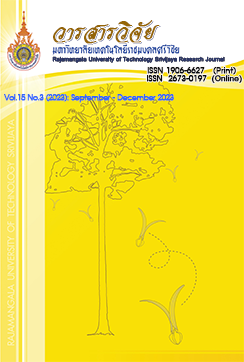Non-destructive Evaluation of Polarization in Sugarcane Stalk Using Near Infrared Hyper Spectral Imaging
Keywords:
sugarcane, polarization, near infrared, non-destructive measurement, hyperspectral imagingAbstract
Near-infrared spectroscopy can be applied to assess polarization (Pol) non-destructively. It can reduce the analysis time compared to conventional methods in the laboratory. However, assessment by near-infrared spectroscopy is a spot measurement on the sugarcane, not covering the surface of the sample. This research applied non-destructive quality analysis using near-infrared hyper spectral imaging technique that can cover the whole surface in scanning to create an image to evaluate the Pol value on the plane area of sugarcane surface. This is an advantage compared to near-infrared spectroscopy techniques. In the study, 300 sugarcane stalks of cultivar Khon Kaen 3 used were harvested at age between 8-11 months from Suphan Buri province. The Pol values of the samples were in the range of 4.93-23.38%. The absorbance of each stalk was measured for in the range of 900-1700 nm. Each cane sample was scanned and measured by placing it on a translational moving platform which conveyed the samples past under the absorbance recording camera of the near-infrared hyperspectral system. The partial least squares regression technique was used to create a Pol prediction equation by studying the effects of wax on the surface of sugarcane. The results showed that the optimal models developed from surface-cleaned sugarcane samples provided the best predictive performance. The determination coefficient was 0.83 and the standard error of prediction was 1.52%. When using the best equation to predict the Pol value of each pixel of the hyperspectral image to create color-mapped image, the color-mapped image visually showed the polarization distribution map with corresponding color over the plane area of the stalk surface. The pol color mapped image revealed that sugarcane at the bottom of the stem had higher Pol value than cane at the top of the stem. The results of this study demonstrated the potential of near-infrared hyperspectral imaging techniques for the future development of fast and non-destructive polarization probes.
References
Aparatana, K., Saengprachatanarug, K., Izumikawa, Y., Nakamura, S. and Taira, E. 2020. Development of sugarcane and trash identification system in sugar production using hyperspectral imaging. Journal of Near Infrared Spectroscopy 28(3): 133-139.
Cantor, S.L., Hoag, S.W., Ellison, C.D., Khan, M.A. and Lyon, C R. 2011. NIR spectroscopy applications in the development of a compacted multiparticulate system for modified release. Aaps Pharmscitech 12(1): 262-278.
Kamwilaisak, K., Jutakridsada, P., Iamamornphanth, W., Saengprachatanarug, K., Kasemsiri, P., Konyai, S. and Chindaprasirt, P. 2021. Estimation of sugar content in sugarcane (Saccharum spp.) variety lumpang 92-11 (lk 92-11) and khon kaen 3 (kk 3) by near infrared spectroscopy. Engineering Journal 25(3): 69-83.
Kirasak, K., Sansayawichai, T., Ponragdee, W. and Thipyawat, A. 2015. Determination of commercial cane sugar (ccs) using near infrared spectroscopy. Thai Agricultural Research Journal 33(2): 159-168. (in Thai).
Manley, M. 2014. Near-infrared spectroscopy and hyperspectral imaging: non-destructive analysis of biological materials. Chemical Society Reviews 43(24): 8200-8214.
Maraphum, K., Saengprachatanarug, K., Aparatana, K., Izumikawa, Y. and Taira, E. 2020. Spatial mapping of Brix and moisture content in sugarcane stalk using hyperspectral imaging. Journal of Near Infrared Spectroscopy 28(4): 167-174.
Miyazawa, M. and Sonoyama, M. 1998. Second derivative near infrared studies on the structural characterization of proteins. Journal of Near Infrared Spectroscopy 6(A): A253-A257.
Osborne, B.G., Fearn, T. and Hindle, P.H. 1993. Practical NIR spectroscopy with applications in food and beverage analysis. Longman Scientific and Technical, Harlow.
Sanseechan, P., Panduangnate, L., Saengprachatanarug, K., Wongpichet, S., Taira, E. and Posom, J. 2018. A portable near infrared spectrometer as a non-destructive tool for rapid screening of solid density stalk in a sugarcane breeding program. Sensing and Bio-sensing Research 20: 34-40.
Taira, E., Ueno, M. and Kawamitsu, Y. 2010. Automated quality evaluation system for net and gross sugarcane samples using near infrared spectroscopy. Journal of Near Infrared Spectroscopy 18(3): 209-215.
Taira, E., Ueno, M., Saengprachatanarug, K. and Kawamitsu, Y. 2013. Direct sugar content analysis for whole stalk sugarcane using a portable near infrared instrument. Journal of Near Infrared Spectroscopy 21(4): 281-287.
Williams, P., Manley, M. and Antoniszyn, J. 2019. Near infrared technology: getting the best out of light. African Sun Media, Stellenbosch.
Zhu, Y.J., Komor, E. and Moore, P.H. 1997. Sucrose accumulation in the sugarcane stem is regulated by the difference between the activities of soluble acid invertase and sucrose phosphate synthase. Plant Physiology 115(2): 609-616.
Downloads
Published
How to Cite
Issue
Section
License
Copyright (c) 2023 Rajamangala University of Technology Srivijaya Research Journal

This work is licensed under a Creative Commons Attribution-NonCommercial-NoDerivatives 4.0 International License.
The content and information in the article published in Journal of Rajamangala University of Technology Srivijaya It is the opinion and responsibility of the author of the article. The editorial journals do not need to agree. Or share any responsibility.







